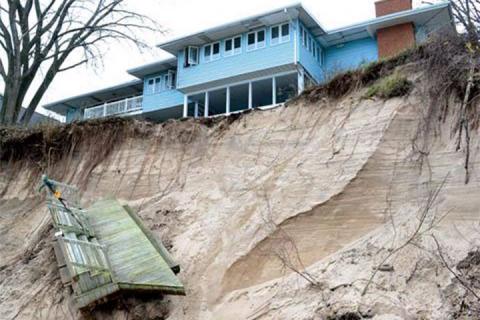Lake Huron Integrated Assessment
“With a focus on Lakes Michigan-Huron, the Integrated Assessment aimed to transform extensive existing research about water levels, flows, and impacts into practical, adaptive strategies to address issues facing shoreline property owners and managers”.
Huron County Integrated Assessment of Extreme Water Levels
This Lake Huron Integrated Assessment was born out of extreme fluctuating water levels on the Lake Michigan and Lake Huron water basins. In 2013 the lakes set all-time record lows. Then between 2013 and 2014 they “experienced one of the largest 2-year gains in water levels in recorded history”. These variations in water levels negatively impacted coastal communities as they were not prepared for these types of extremes. The goal of this project was to determine what policy and management strategies could feasibly be implemented to make these communities resilient in the face of unknown climactic changes. This project involved collaboration with stakeholders from Canada and the US to assess the impacts and determine adaptive strategies for water level variability. Partnerships were formed with binational research teams and coastal communities affected by extreme water level fluctuations. In the end, 23 recommendations were created with 6 themes for adaptive management and policy action. Funding for this project was provided by the University of Michigan Graham Sustainability Institute and Water Center, Michigan Coastal Zone Management Program, and NOAA.
Some of the recommendations that came out of the Huron County Integrated Assessment have been incorporated into the Shoreline Management Plan within Ausable Bayfield Conservation Authority’s area.
Highlights from the plan:
- Consistent, up-to-date guide for development and land use planning along the shoreline
- Technical information on shoreline processes and coastal hazards
- Integrates local policies with the Province of Ontario Policy
- Reflects stakeholder input
Now, 5 years later, we are checking back in on what impact the Integrated Assessment has made. We interviewed Lynne Peterson, the project lead and author for the Huron County Extreme Lake Levels integrated assessment, about what her thoughts are.
1. Can you describe the project and your involvement?
The Huron County Extreme Lake Levels integrated assessment was one of four projects sponsored and overseen by the University of Michigan’s Graham Sustainability Institute, and kicked off in 2015. I completed work on the Huron County Extreme Lake Levels integrated assessment in 2017 and have not been directly involved since then. The Huron County project was the only Canadian study, so our policy and governance environment is different from that in the U.S. There were three phases, each with a report – Phase One was issue identification, Phase Two involved development of recommendations, and Phase Three was the University of Michigan’s combination of all the projects to identify common trends and themes.
2. What was the most important and useful aspect of the Huron County Study?
On the Huron County project, we worked directly and closely with local Conservation Authorities, municipalities, environmental groups, business and residents groups to identify issues and recommendations. A key goal was education of local authorities, businesses and residents, making them aware of the climate change-related trends and prepping them for future action. I geared our recommendations to actions they could take locally to address the local issues they identified created by extreme lake levels. Interestingly, in 2015 when we started, climate change was not yet generally accepted in many U.S. jurisdictions and high water levels in the Great Lakes were just starting to have an impact. By 2017, of course, there was much more evidence of both, and the resulting trend toward more extreme weather events was becoming noticeable.
3. What were some challenges the project faced?
The Huron County project was controversial from several perspectives and had to be conducted with sensitivity. There was still some academic disagreement about whether the previous decade of low water levels in the Great Lakes was going to continue indefinitely despite the previous year’s notable increase, which made framing the issues complicated. Global warming and climate change were still not widely recognized by the public and local authorities the way they are today. Property owners generally resist hearing that their expensive lake-front properties might be at risk of sliding into the lake, or that all home insurance policies specifically exclude losses from erosion. Public meetings held by conservation authorities and municipalities to get input on possible policy and program changes are generally heated and unpleasant. And our approach looked at measures that could be taken by local environmental and local government authorities to deal with issues that are global in scope. At this point, the federal and provincial governments had not yet engaged in significant policy and program development to help local authorities with climate change adaptation and mitigation.
The Conservation Authorities in Huron County, in particular, and the municipalities as well, took ownership of these issues following our work together on the Integrated Assessment. There has been a great deal of further consultation with, and education of, residents whose properties are most vulnerable to these hazards. The Ausable Bayfield Conservation Authority undertook an update of its Shoreline Management Plan, which was approved in 2019.
5. Looking back, what reflections do you have?
It was a very interesting project on what were clearly important future climate change trends that require awareness, preparation and action to avoid undue disasters for residents and local authorities. I particularly liked the integration intent of U of M’s initiative – social, economic and environmental – giving a full picture of impacts and challenges.







